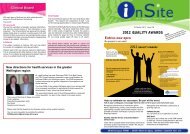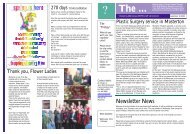Te Arawhata Totika - Wairarapa DHB
Te Arawhata Totika - Wairarapa DHB
Te Arawhata Totika - Wairarapa DHB
You also want an ePaper? Increase the reach of your titles
YUMPU automatically turns print PDFs into web optimized ePapers that Google loves.
where some felt that an inability to pay fees, how-<br />
ever small, would constrain their right to access<br />
care. This view has persisted, and access to care<br />
is still always given as a priority when consulting<br />
with whänau.<br />
Period 5: Kaupapa Hauora Mäori and<br />
health service provision in the 21st<br />
Century<br />
Current Crown health policy suggests that<br />
health service provision is now more likely to<br />
focus on and incorporate Mäori philosophy<br />
or world view. This suggests that:<br />
• issues about cultural safety and quality<br />
have been or are being addressed<br />
• a consensus has been reached on what is<br />
required to achieve cultural quality standards<br />
• the establishment of health services<br />
clearly state the processes involved<br />
for measuring achievement<br />
• Mäori health objectives are clearly identified<br />
through Crown health policies such as<br />
he korowai Oranga (The Mäori health<br />
Strategy 2002) and whakatätaka Tuarua<br />
(Mäori health Action Plan 2006-2011)<br />
The providers of these services are more likely<br />
to have established a set of health outcomes<br />
that reflect the holistic nature of hauora, and<br />
they can demonstrate that health gains are being<br />
achieved through reflection on the experiences<br />
of providers and consumers. Noted are:<br />
• recognition of culture as a determinant to good<br />
health<br />
• distinction between clinical leadership and<br />
health leadership reference is made to both<br />
the recognition of clinical skills as a basis<br />
for intervention and to the acquisition of<br />
skills that can relate to Mäori realities.<br />
Durie (1994) has provided a set of charac ter istics<br />
of Mäori health services that support and<br />
reinforce these, citing the four characteristics<br />
of a Mäori health service as having:<br />
• clinical inputs consistent with the best<br />
possible outcomes<br />
• a cultural context that makes sense to clients<br />
and their whänau<br />
• outcome measures that are similarly focused<br />
• integration of the services with aspects of<br />
positive Mäori development<br />
Conclusion<br />
The concept of kaupapa hauora can be identified<br />
throughout the history of health service<br />
develop ment and delivery within Aotearoa. From<br />
before 1800 to the present day it is possible to<br />
locate a values-based concept of hauora as being<br />
central to the development of both the system of<br />
hauora and the public health system that was part<br />
of our social structure.<br />
with the start of the european migration in 1800<br />
this concept was displaced and eroded as western<br />
structures and methods were introduced. Although<br />
still present, kaupapa hauora lost its primacy as other<br />
systems replaced it. The influence of missionaries<br />
and the introduction of native medical officers and<br />
native school health initiatives attempted to address<br />
some of the weaknesses within the developing health<br />
systems, but the methods used were based on<br />
western frameworks and did not recognise the need<br />
to address the values base central to the<br />
successful systems of hauora.<br />
it was not until the 1900s that there was resurgence<br />
and a reactivation of the concept of kaupapa<br />
hauora, brought about in part by the requirements<br />
of the Department of health to seek Mäori advice<br />
when planning for Mäori health. To this end, the<br />
appointments of Pomare in 1900 and Buck in 1905<br />
were made. They worked as native Medical Officers<br />
in Taranaki and provided the Government with<br />
the Mäori advice they were seeking. Despite their<br />
best efforts and their ability to motivate their own<br />
people, the models of health care remained within<br />
a western system of health care, and were not<br />
allocated sufficient funding to implement fully the<br />
proposed changes to environ mental and personal<br />
health. Mäori began to express concerns about the<br />
health care systems that were not meeting their<br />
needs, and the development of the Women’s Health<br />
League and the Mäori Women’s Welfare League<br />
both developed health strategies that focused upon<br />
the health of whänau. These two organisations<br />
remain in force today, still playing a key role in the<br />
development of whänau-based health services,<br />
participating in national programmes such as<br />
immunisation, and becoming involved in research<br />
while trying to tailor services to incorporate a<br />
kaupapa hauora approach to service delivery.<br />
From 1980 onwards Mäori demanded that they be<br />
heard and that health services meet their stated<br />
needs in a manner that had meaning for Mäori.<br />
The emergence of models for Mäori health were<br />
developed and presented and were accepted both<br />
by Mäori and the Crown as a legitimate way in which<br />
to develop services for Mäori that allowed them to<br />
develop value-based kaupapa hauora services.<br />
The health infrastructure underwent many<br />
changes from the late 1960s; kaupapa hauora<br />
can be identified in health services from te wa<br />
Mäori through to the present day. it is not a new<br />
concept, rather it has always been present; at times<br />
only vestiges of the concept could be located,<br />
while at other times its presence is strong.<br />
<strong>Te</strong> <strong>Arawhata</strong> Tötika Cultural Competency Framework<br />
13







